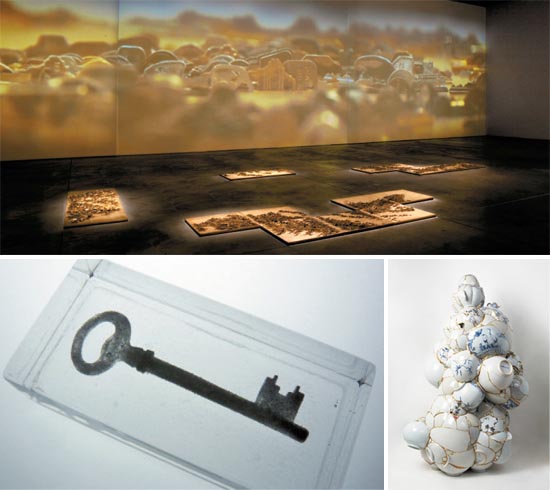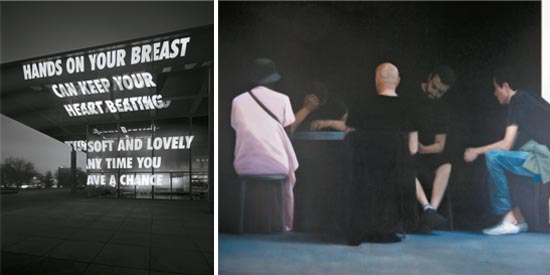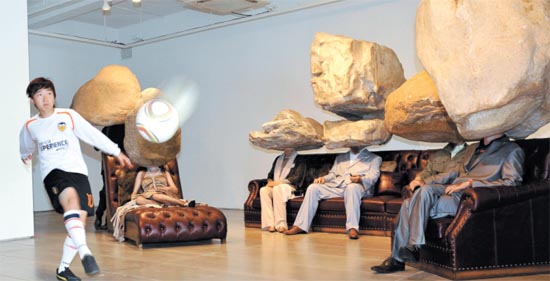Five fall exhibitions fit for a royal palace

Spend a day strolling through these storied streets, and then pop into one of the many inviting cafes or restaurants in nearby Samcheong-dong for refreshments before heading back out for another round of gallery hopping.
Here are five must-see exhibitions at major galleries in the neighborhood. Included in the bunch is a group show featuring four female Asian artists ranging from the famous Yayoi Kusama to the emerging Korean-American Jean Shin; four solo shows by German painter Tim Eitel, a rising international talent; renowned U.S. conceptual artist Jenny Holzer; provocative Chinese duo Sun Yuan and Peng Yu; and the deceased local conceptual artist Yiso Bahc.

Jean Shin’s installation and the digital video projection “Lost Vista” (2010), Aiko Miyanaga’s naphthalene and mixed media installation “Dwelling in a boat -key-” (2011) and Yeesookyung’s sculpture “Translated Vase” (2007). Provided by Gallery Hyundai
Gallery Hyundai
Waves of meaning flow on tides of elegant repetition
At first glance, the four artists in the group exhibition “Epic of Units” at Gallery Hyundai would seem to have little in common except for the fact that they are all Asian women. But their use of repetition to convey meaning is the through line that connects them.
Probably the most well-known is Japanese artist Yayoi Kusama, 82, renowned for her obsession with and fear of dots, qualities she has sublimated into her art.
There are two Korean artists in the show, including Yeesookyung, 48, known for sculptures with abandoned fragments of ceramics attached by a gold leaf and epoxy mixture. The other is Korean-American Jean Shin, 41, who makes monumental installations with found objects such as keys or prescription drug bottles. Her installation was created with more than 8,000 old copper keys collected from Arizona residents, to form what look like sand dunes in the desert. The piece is paired with a massive video projection that magnifies parts of the installation, though the effect is more like ocean waves.
“Viewers tend to project things that are familiar to them into artworks, and my work is open to various interpretations,” said Shin, who is in Seoul for the show.
The final artist is Japan’s Aiko Miyanaga, 37. She makes objects that are seen in everyday life - a key, a watch - but which can be read as symbols.
“They evaporate sometimes quickly and sometimes very slowly, as I intend,” said the artist, who is also in town for the exhibition.
Joo Henna, deputy director of gallery Hyundai, described the artists’ works as a departure from postmodern works focusing on spectacles. Instead, these are delicate works infused with emotion and related to healing.
“Their works, whether formed from units of behavior, of material, or of thought, create new meanings through constant repetition,” Joo said.
The exhibition runs through Oct. 2. Admission is free. Hours are 10 a.m. to 6 p.m. Tuesdays to Sundays. Call (02) 2287-3500 or visit www.galleryhyundai.com.

Left: “HANDS ON” (2011) by Jenny Holzer is pigment print of her light projection work. Provided by Kukje Gallery
Right: “Five Men Around a Table” (2011) by Tim Eitel Provided by Hakgojae
Kukje Gallery
Woman of words puts the writing on the wall
Jenny Holzer, a renowned conceptual artist and a pioneer in the use of text in contemporary art, is holding her second solo show in Korea.
Her exhibit at Kukje Gallery includes two LED signs arranged into sculptures, eight marble footstools, on each of which a sentence is inscribed, and 13 black-and-white prints showing sentences projected onto buildings.
Whereas many artists have used letters and type as patterns in their paintings, Holzer makes art of text and its meaning. She made a name for herself with provocative, often witty, statements projected onto a gigantic billboard in Times Square in 1982.
She became the first female artist to represent the United States at the 1990 Venice Biennale, and was awarded the Leone D’Oro that year.
She used to write all the texts herself. But since 1993, she has mainly been working with texts written by others, including famous authors. Her works are placed or projected onto various surfaces ranging from electric signs to stone benches.
“While language has always functioned as Holzer’s primary medium, it cannot be dissociated from the ingenious and sly choice of the surface that holds the text,” Kukje Gallery said in a press release. “From posters, bronze plaques and marble benches to electronic signs and light projections, her work questions how modes of mass address form publics and communities.”
In recent years, she has begun projecting statements and aphorisms onto buildings in Rome, Berlin, London and other historic world capitals.
The show runs through Oct. 16. Admission is free. Hours are 10 a.m. to 6 p.m. Mondays to Saturdays and until 5 p.m. on Sundays. Call (02) 735-8449 or visit www.kukje.org.
Hakgojae
Paintings infused with loss and a hint of mystery
Amid the recent flood of flamboyant Pop Art prints, new media works and installations, Tim Eitel’s calm paintings with realistic figures and simplified details project a distinctive atmosphere. Sixteen paintings by the 40-year-old German artist are now on display at Hakgojae, as part of his first solo show in Asia titled “The Placeholders.”
All the paintings depict scenes that are common in daily life. But because of details and backgrounds that have been intentionally omitted or simplified by the artist, the images remain ambiguous and sometimes even mysterious.
“Rather than tell a certain story, I’d like to let viewers project their own experiences and memories onto the paintings and make various interpretations,” Eitel told reporters at a press preview at the gallery late last month.
The paintings in this show are either very large, at more than 2 meters, or very small, at around 20 centimeters.
“The small paintings are for more intimate contact with viewers and the large ones are to extend the space so that viewers can feel like they are part of the paintings,” the artist explained.
Several of the paintings depict homeless people or their traces, such as an empty cot on the street that the artist saw in Los Angeles in 2005, conveying a deep sense of loss, isolation and loneliness.
Eitel is a member of the New Leipzig School, a group of relatively young artists based in the former East Germany, though he was born in the former West Germany. The artists mainly make figurative paintings with a combination of realist and symbolist styles.
The show runs through Oct. 23. Admission is free. Hours are 10 a.m. to 7 p.m. Tuesdays to Saturdays and to 6 p.m. on Sundays. Call (02) 720-1524~6 or visit www.hakgojae.com.

“Teenager Teenager” (2011) by Chinese artist duo Sun Yuan and Peng Yu is exhibited at Arario Seoul [NEWSIS]
Arario Seoul
Stone cold sculpture with freedom for play
It’s a strange sight to see in a gallery window, but the current installation at Arario Seoul will bring you to a dead stop as you stand outside staring in. Through the large plate glass window, a boy kicks a football around as if out on the pitch instead of inside an art institution. Go inside and the scene is even more strange. Seated on a group of leather sofas and chairs is a group of well-dressed adults whose heads have been replaced by huge misshapen stones. Of course, these are sculptures but their hyperrealistic appearance gives off a very uncanny feeling. Meanwhile, the boy (who is a real person) continues to play with the football, sometimes kicking it into the window, oblivious to the visitors around him.
“Don’t worry, this is antishock glass,” Ryu Jung-hwa, Arario’s curator, told reporters at a recent press event. The work, titled “Teenager Teenager,” is by Chinese artists Sun Yuan and Peng Yu, who are also a couple.
“The adults have fossilized heads and look indifferently at the teenager,” said Gu Zenqing, curator of Beijing’s Li-Space, who came to Seoul to curate this exhibition. “But the work is open to various interpretations.”
Their heads are so big “to reinforce the strangeness,” Sun, who is here with Peng, said. “We wanted to make them even bigger. But the galley space was limited.”
Arario said in a press release that the piece was created to “confront the influx of commercial culture, while offering rare insight into individual freedom.”
The show runs until Oct. 9. Admission is free. Hours are 11 a.m. to 7 p.m. Tuesdays to Sundays. Call (02) 723-6190 or visit www.arariogallery.com.
Artsonje Center
Drawings for deciphering an artist and his work

The drawing for “Today” (circa 2000) is part of the “Yiso Bahc - Lines of Flight” show. Provided by Artsonje Center
One of the most impressive works here is a drawing for “We Are Happy” (2004), a billboard with the words in Korean printed in white letters against a pale orange background. The sign was completed on the basis of this drawing and other blueprints by Bahc after his sudden death from a heart attack. It was then shown at the 2004 Busan Biennale.
With its upbeat message and bright colors, there is something ironic about the billboard, which itself reads like propaganda.
“Yiso Bahc ceaselessly recorded his ideas in notes and drawings,” the museum said in a press release. “For him, drawing was yet another tool for materializing and developing his conceptual attitude and creative domain.”
According to the museum, the drawings in the exhibition can be categorized into three types: drawings on the themes of identity, ego, multiculturalism and social issues; drawing concepts that concretely represent the conceptual side of his installations; and an installation portfolio that Bahc repeatedly modified for production and installation of his works.
The show runs until Oct. 23. Admission is 3,000 won for adults. Hours are 11 a.m. to 7 p.m. Tuesdays to Sundays. Call (02) 733-8941 or visit http://artsonje.org/asc/.
By Moon So-young [symoon@joongang.co.kr]
한글 관련 기사 [중앙일보]
전광판이 예술이 될 때
개념미술가 제니 홀저 개인전
흑백사진·LED 작업 등 23점 선봬
“내가 욕망하는 것들로부터 나를 지켜주세요(Protect Me From What I Want )”
1985년 소비 문화의 본산, 뉴욕 타임스 스퀘어 전광판엔 마치 성경구절 같은 이 경구가 흘러갔다. 미국의 개념미술가 제니 홀저(Jenny Holzer·61)의 작품이었다. 그는 이 작품으로 소비중독에 빠진 오늘의 상황을 보여주는 동시에, 번화가의 전광판이 예술이 될 수 있음을 보여줬다. 전광판은 뉴스와 광고의 전유물이었다. 제니 홀저는 이걸 미술 작품의 캔버스처럼 사용했다. 영상을 배제하고, 짧은 문장들로 이뤄진 강렬한 메시지를 보냈다. 뉴욕의 월드 트레이드 센터와 휘트니 미술관, 독일 국회의사당, 뉴욕과 빌바오 구겐하임 미술관 등 그의 전광판 작업은 세계 곳곳에서 번쩍였다. 90년에는 베니스 비엔날레 미국관 대표작가로 전시, 황금사자상을 받았다.
제니 홀저 ‘전광판 작가’ 제니 홀저의 개인전이 서울 소격동 국제갤러리에서 열리고 있다. 2004년에 이은 국내 두 번째 개인전이다. 문장을 건물에 투사시킨 뒤 이를 찍은 흑백 사진, 발광 다이오드(LED) 전광판 작업, 대리석 의자에 “다른 누군가의 육체는 당신의 정신을 위한 안식처(Someone Else’s Body is a Place for Your Mind to Go)” 같은 의미심장한 문구를 새긴 조각 등 23점을 선보인다. 전시를 위해 방한한 작가는 “사람들이 설교하듯 일방적으로 메시지를 전달하는 것에 나는 강한 의구심을 갖고 있다. 때문에 인과관계가 결여된 다양한 문장들을 흘러가도록 보여준다”고 말했다. “무명의 거리 예술가로 출발한 나는 전시장 만이 아니라 곳곳에서 사람들이 예술을 접하길 원했다. 그걸 여섯 살 때 매료된 타임스 스퀘어의 빛나는 전광판에서 발견했다”고도 덧붙였다. 10월 16일까지, 무료. 02-733-8449.










with the Korea JoongAng Daily
To write comments, please log in to one of the accounts.
Standards Board Policy (0/250자)